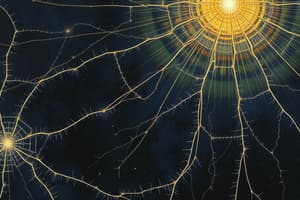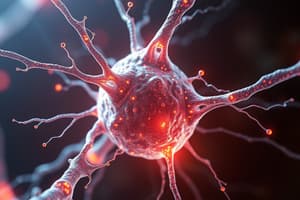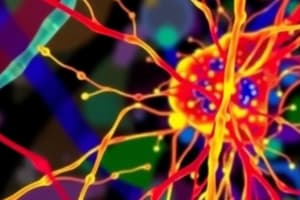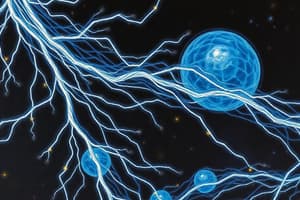Podcast
Questions and Answers
Which protein is primarily responsible for microtubule nucleation?
Which protein is primarily responsible for microtubule nucleation?
Which of the following statements about motor proteins is true?
Which of the following statements about motor proteins is true?
What role do microtubules play during cell division?
What role do microtubules play during cell division?
How do cilia and flagella achieve movement?
How do cilia and flagella achieve movement?
Signup and view all the answers
What is one of the roles of actin microfilaments (MF) mentioned?
What is one of the roles of actin microfilaments (MF) mentioned?
Signup and view all the answers
What is the role of ARP2/3 in cell migration?
What is the role of ARP2/3 in cell migration?
Signup and view all the answers
Which myosin family protein is primarily responsible for muscle contraction?
Which myosin family protein is primarily responsible for muscle contraction?
Signup and view all the answers
What occurs when the balance between polymerization and depolymerization in microtubules is disturbed?
What occurs when the balance between polymerization and depolymerization in microtubules is disturbed?
Signup and view all the answers
Which G-protein is responsible for the formation of lamellipods that aid in cell migration?
Which G-protein is responsible for the formation of lamellipods that aid in cell migration?
Signup and view all the answers
What is the primary function of Tropomyosin in relation to actin microfilaments?
What is the primary function of Tropomyosin in relation to actin microfilaments?
Signup and view all the answers
What type of tubulins combine to form protofilaments in microtubule assembly?
What type of tubulins combine to form protofilaments in microtubule assembly?
Signup and view all the answers
Which of the following proteins prevents actin microfilament polymerization?
Which of the following proteins prevents actin microfilament polymerization?
Signup and view all the answers
What is the role of Ran in cellular mechanisms?
What is the role of Ran in cellular mechanisms?
Signup and view all the answers
What is the primary composition of the cytoplasm?
What is the primary composition of the cytoplasm?
Signup and view all the answers
What is NOT a function of the cytoskeleton?
What is NOT a function of the cytoskeleton?
Signup and view all the answers
Which protein structure forms actin monomers?
Which protein structure forms actin monomers?
Signup and view all the answers
What initiates actin polymerization?
What initiates actin polymerization?
Signup and view all the answers
What type of cytoskeletal protein is primarily involved in maintaining cell shape?
What type of cytoskeletal protein is primarily involved in maintaining cell shape?
Signup and view all the answers
What process describes the movement of white blood cells outside of blood vessels?
What process describes the movement of white blood cells outside of blood vessels?
Signup and view all the answers
Which of the following is considered an inert inclusion in the cytoplasm?
Which of the following is considered an inert inclusion in the cytoplasm?
Signup and view all the answers
Which cytoskeletal component is characterized by its larger diameter?
Which cytoskeletal component is characterized by its larger diameter?
Signup and view all the answers
Actin polymerization to form F-actin requires which of the following?
Actin polymerization to form F-actin requires which of the following?
Signup and view all the answers
Which role is NOT associated with actin microfilaments?
Which role is NOT associated with actin microfilaments?
Signup and view all the answers
What is the primary role of intermediate filaments in cells?
What is the primary role of intermediate filaments in cells?
Signup and view all the answers
Which of the following is true about the assembly of intermediate filaments?
Which of the following is true about the assembly of intermediate filaments?
Signup and view all the answers
Which of the following statements correctly describes the function of colchicine?
Which of the following statements correctly describes the function of colchicine?
Signup and view all the answers
Which intermediate filament type is specifically found in muscle cells?
Which intermediate filament type is specifically found in muscle cells?
Signup and view all the answers
What can intermediate filaments be used to determine in a clinical setting?
What can intermediate filaments be used to determine in a clinical setting?
Signup and view all the answers
What condition is caused by genetic abnormalities affecting the links in intermediate filaments?
What condition is caused by genetic abnormalities affecting the links in intermediate filaments?
Signup and view all the answers
What is one of the main functions of intermediate filaments related to mechanical stress?
What is one of the main functions of intermediate filaments related to mechanical stress?
Signup and view all the answers
Which drug is known for preventing mitotic spindle depolymerization?
Which drug is known for preventing mitotic spindle depolymerization?
Signup and view all the answers
Study Notes
Chapter 3: Cytoskeleton
- The cytoskeleton is a network of filamentous proteins within the cytoplasm
- It provides mechanical support, maintains cell shape, and enables cell motility
- It facilitates chromosome migration during mitosis, organelle movement, and biochemical reactions
- The cytoskeleton includes actin microfilaments (AF), intermediate filaments (IF), and microtubules (MT)
Cytoplasm Composition
- Cytoplasm (cytosol, hyaloplasm) is a jelly-like fluid with
- Water (70%)
- Small molecules (low MW): ions, gases, glucose, amino acids, fatty acids, urea, glycerol
- Large molecules (high MW): proteins, lipids, carbohydrates, nucleic acids (RNA)
- Inert inclusions (non-living)
- Proteins (proteasome)
- Lipids (droplets)
- Carbohydrates (rosettes, little clouds)
Cytoskeletal Components
- Actin Microfilaments (AF): 5-8 nm diameter
- Intermediate Filaments (IF) : 8-10 nm diameter
- Microtubules (MT): 20-30 nm diameter
Actin Microfilaments (AMF) Structure and Nucleation
- Monomer: G-actin (globular protein) with 1 ATP groove
- Polymer: Several G-actins bind together to form F-actin. ATP grooves on same side. Involves ARP2/3 (a complex) forming 2 twisted chains.
Actin Polymerization/Depolymerization
- ATP hydrolysis drives polymerization and depolymerization
- Polymerization occurs at the plus end, while depolymerization occurs at the minus end
- Factors like ARP2/3, Profilin, and CapZ regulate polymerization
- The polymerization/depolymerization rate depends on G-actin/ATP concentration
- The plus end is referred to as a barbed end and the minus end is a pointed end
AMF Roles
- Maintain cell shape using cellular cortex (actin layer)
- Enable cytoplasmic currents (movement of molecules and organelles)
- Support structures like microvilli (intestinal and kidney cells)
- Facilitate vesicle exchanges (endocytosis/exocytosis)
- Essential during cell division: forms a contractile ring
- Enables diapedesis (movement of white blood cells out of vessels)
- Enables cell migration by the polymerization and depolymerization of AMFs
Microtubules (MT)
- Organize the positions of organelles
- Direct intracellular transport
- Composed of tubulin dimers (α-tubulin and β-tubulin) arranged in a hollow tube structure with 13 protofilaments per circumference.
MT Structure and Assembly
- Monomer: α-tubulin and β-tubulin
- Polymerization: Tubulin dimers bind to each other using GTP, forming protofilaments. 13 protofilaments combine to form a microtubule
- The γ-TuRC complex is crucial for MT nucleation (initiating assembly). It's considered a strong nucleator.
- MTs are stabilized by accessory proteins. MAP2 is a common example.
MT Polymerization
- Depends on equilibrium between free and bound tubulins. Free GTP form leads to polymerization; otherwise depolymerization.
- Imbalance in the GTP-bound to GDP-bound tubulin ratio can cause instability and collapse. This is called a disaster phenomenon.
MT Associated Proteins
- γ-TuRC: MT nucleation
- MAP2: MT stability
- Kinetochore: Attaches chromosomes to mitotic spindle during mitosis
- Motor proteins (Kinesin and Dynein): convert chemical energy into mechanical energy for transport of cargo along microtubules. Kinesin moves towards the + end, Dynein towards the minus end.
Intermediate Filaments (IF)
- Stability: Never polymerize or depolymerize
- Cytoskeleton Role: Maintain cell shape
- Nuclear Lamina: Form a nuclear lamina in the nucleus (3 types of lamins: A, B, and C). Reinforces the nuclear envelope. They are crucial against the pressure of the nucleus.
- Diagnostics: Used in immunohistochemistry (IHC) to determine the cancer type
-
Families:
- Keratins (epithelial cells) - crucial in diagnosing carcinomas
- Desmin (muscle cells, myoblastomas)
- Vimentin (connective tissue, sarcomas)
- Neurofilaments (neurons, neuroblastomas)
- GFAP (glial cells, gliomas)
IF Structure and Assembly
- Composed of filamentous monomers with two heads
- Monomers form dimers, followed by tetramers, then a rope-like structure. The specific tetramer arrangements within the rope will depend on the type of intermediate filament.
IF Functions
- Morphogenesis: Forms a scaffold for maintaining cell shape.
- Muscles: In muscle cells, IFs orient actin and myosin to maintain organization, and thus contraction.
- Resistance: IFs link desmosomes and hemidesmosomes to each other for cell resistance. Disruptions in this can cause diseases like epidermolysis bullosa.
Cilia and Flagella
- Microtubules control their beating
- Cilia move fluids (e.g., mucus in the throat)
- Flagella propel cells (e.g., sperm)
Axonal Transport
- Kinesin and Dynein move cargo along microtubules. Kinesin moves towards the + end and Dynein moves towards the - end.
- Cargo can be transported in either direction.
Centrosomes and Centrioles
- Centrosomes have a pair of centrioles at its core
- Centrioles are made of microtubules arranged in a specific configuration that differ in their longitudinal and cross sections.
Pharmacological Effects on MTs
- Certain drugs (e.g., colchicine, taxol, vincristin, podophyllotoxin) interfere with MTs, impacting polymerization, depolymerization, and overall microtubule function. This is a major target in chemotherapy and cancer treatment.
Studying That Suits You
Use AI to generate personalized quizzes and flashcards to suit your learning preferences.
Related Documents
Description
Test your knowledge on microtubules and cytoskeletal proteins with this quiz. It covers key concepts such as protein roles in cell division, movement mechanisms of cilia and flagella, and the function of major proteins like myosin and tropomyosin. Assess your understanding of cell migration and the cytoplasmic composition.




